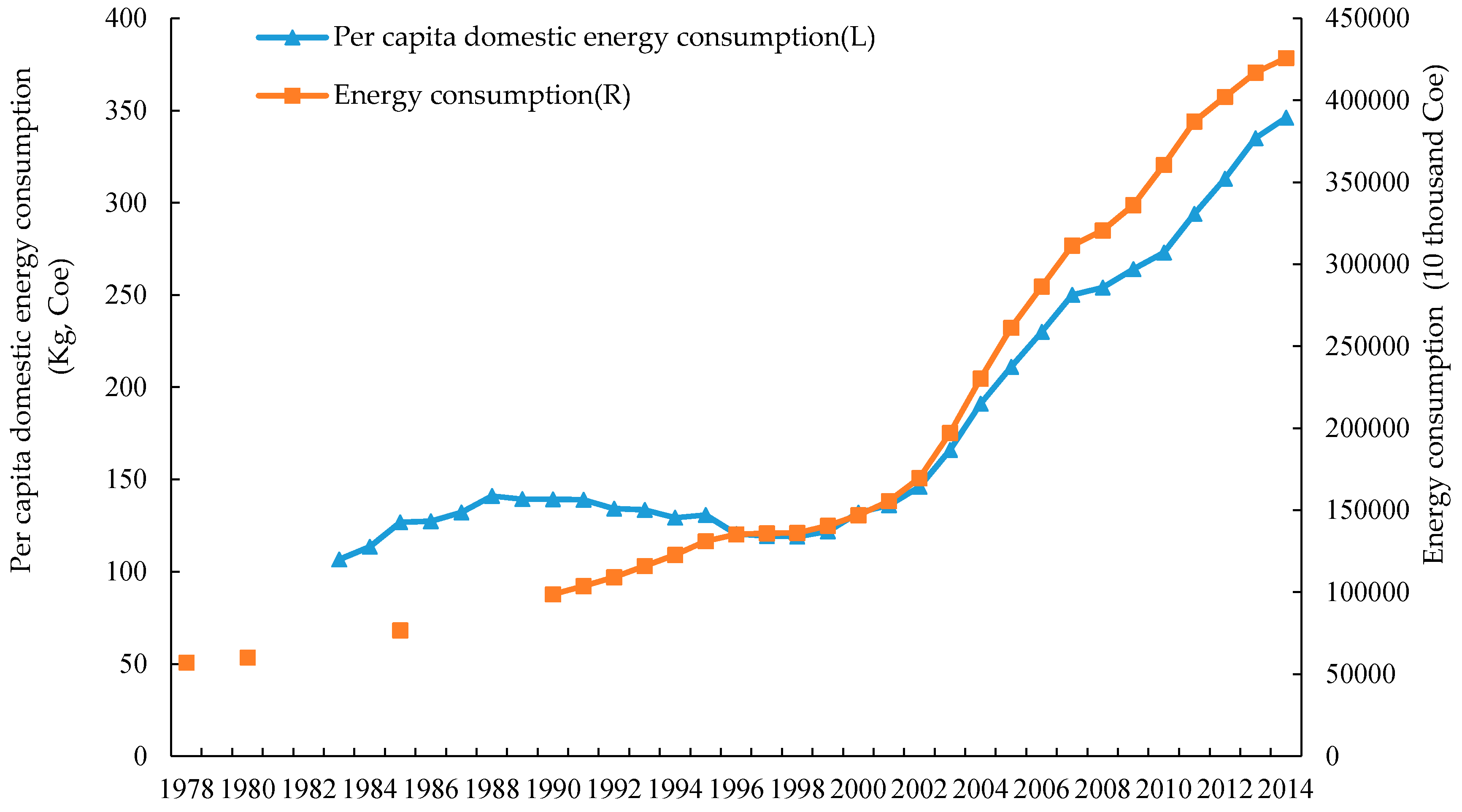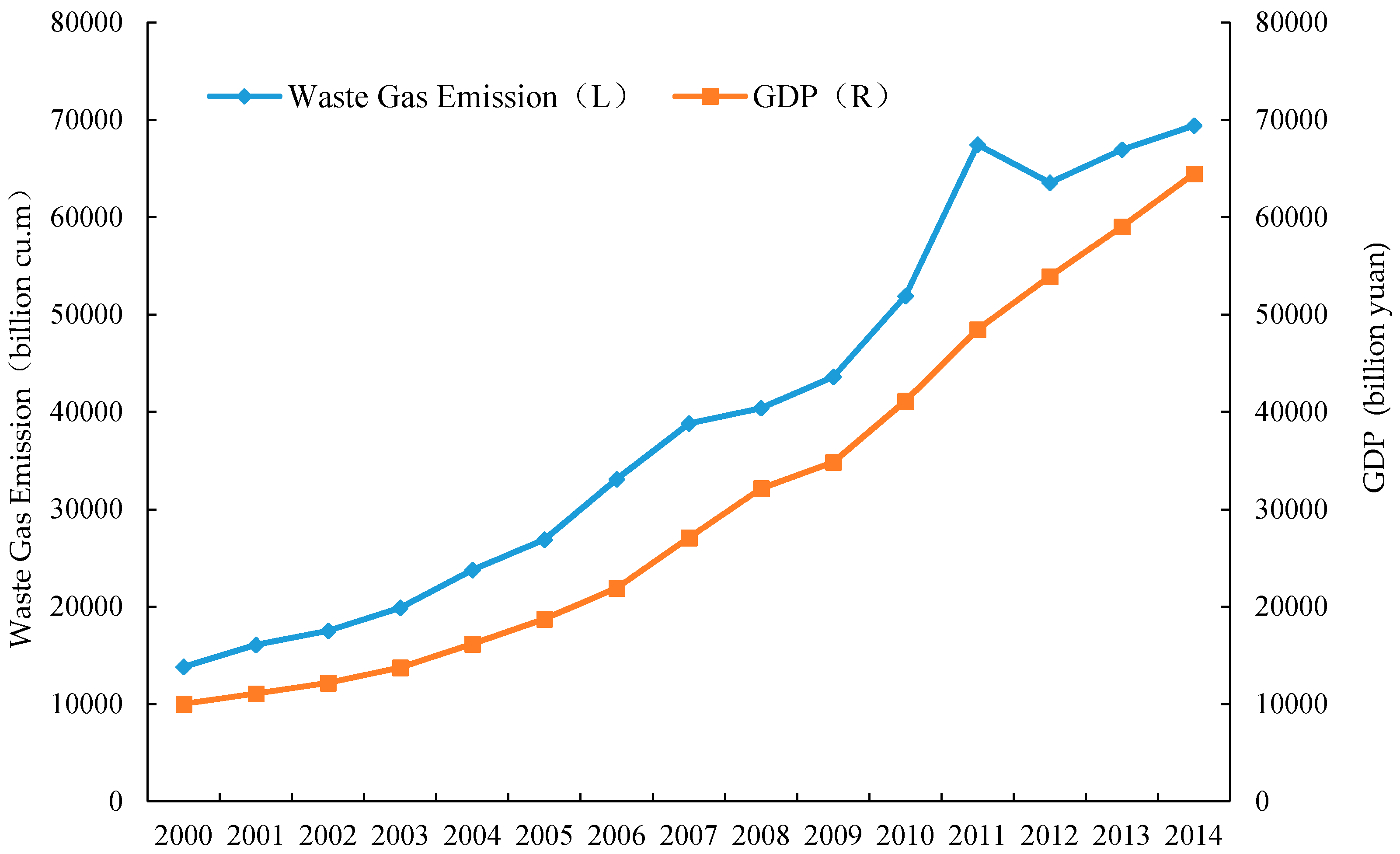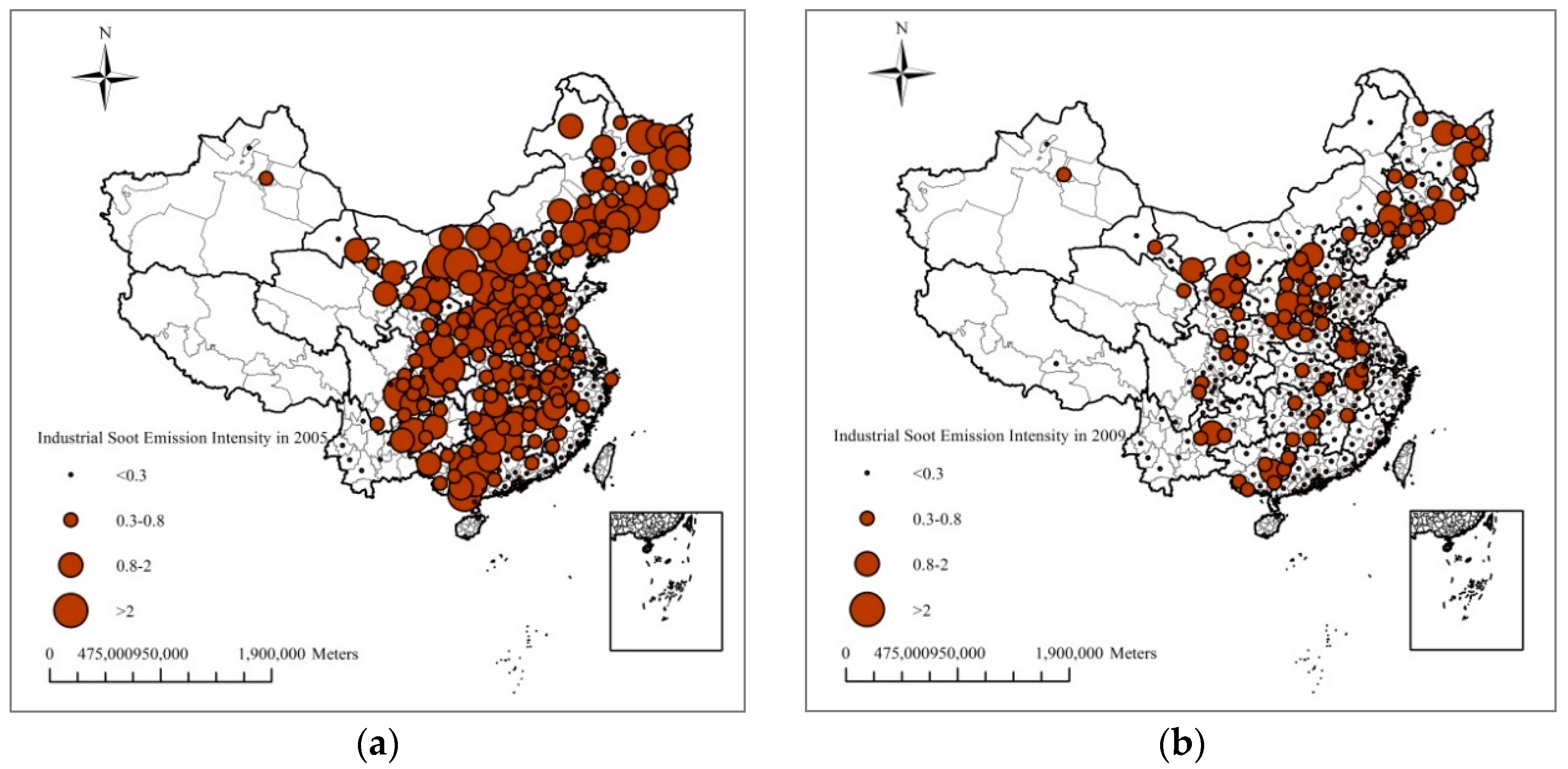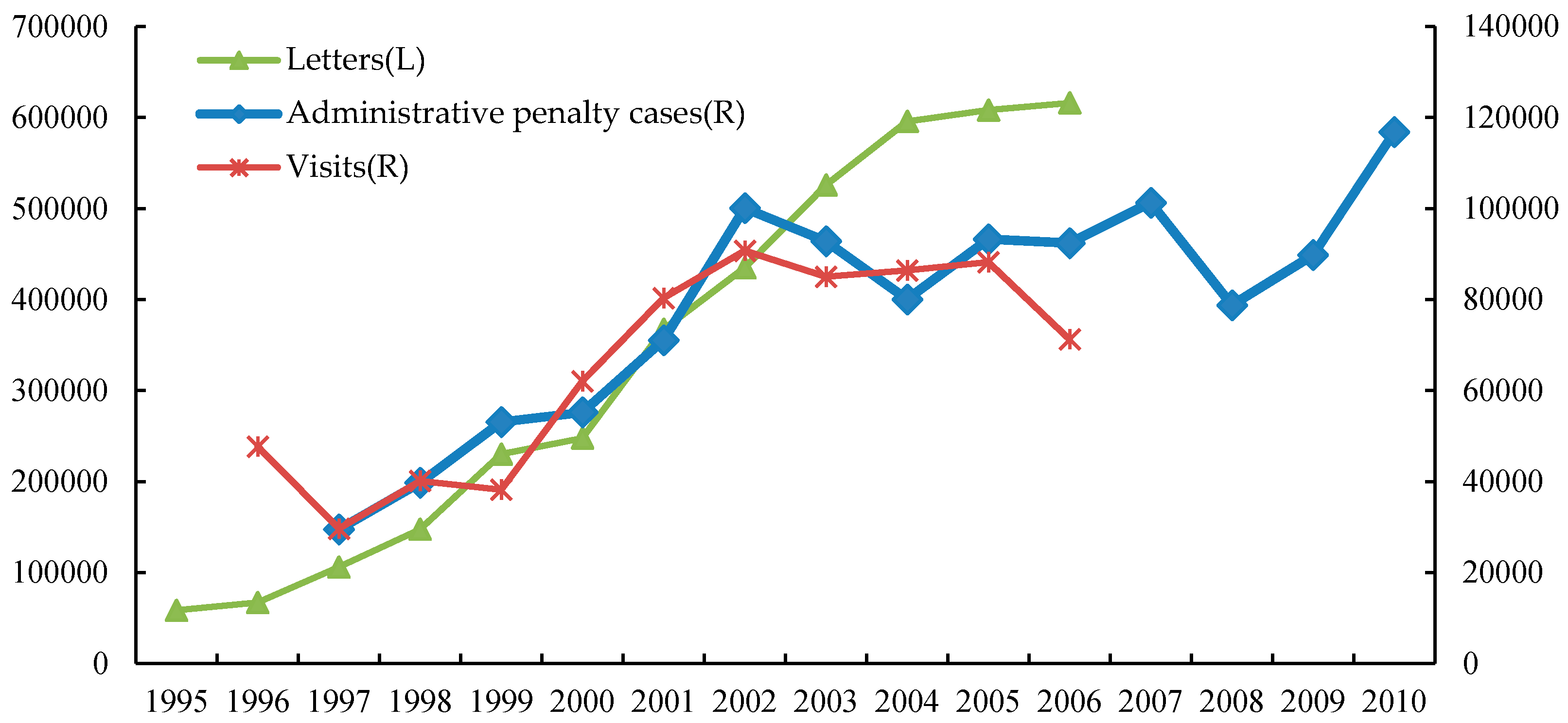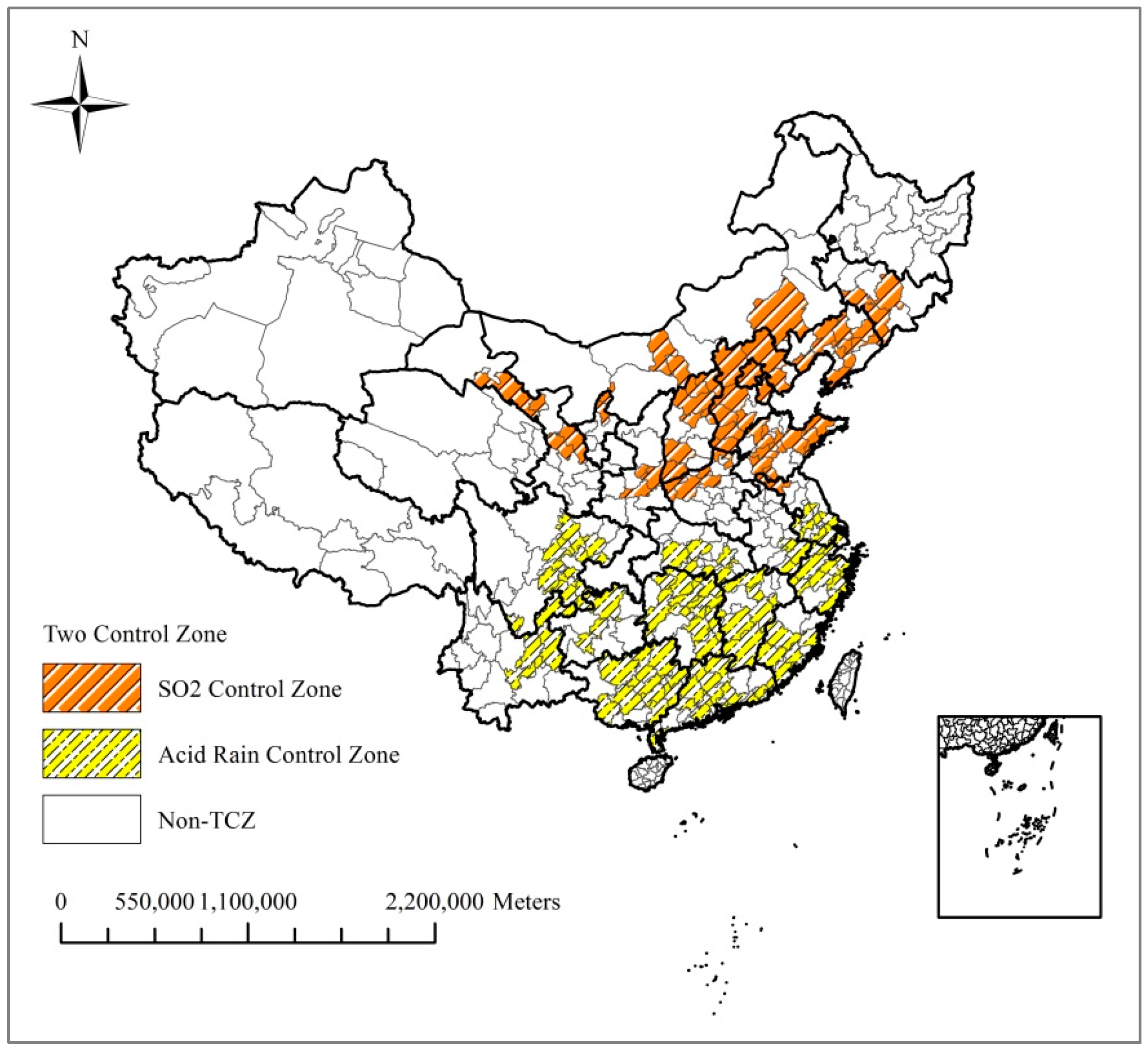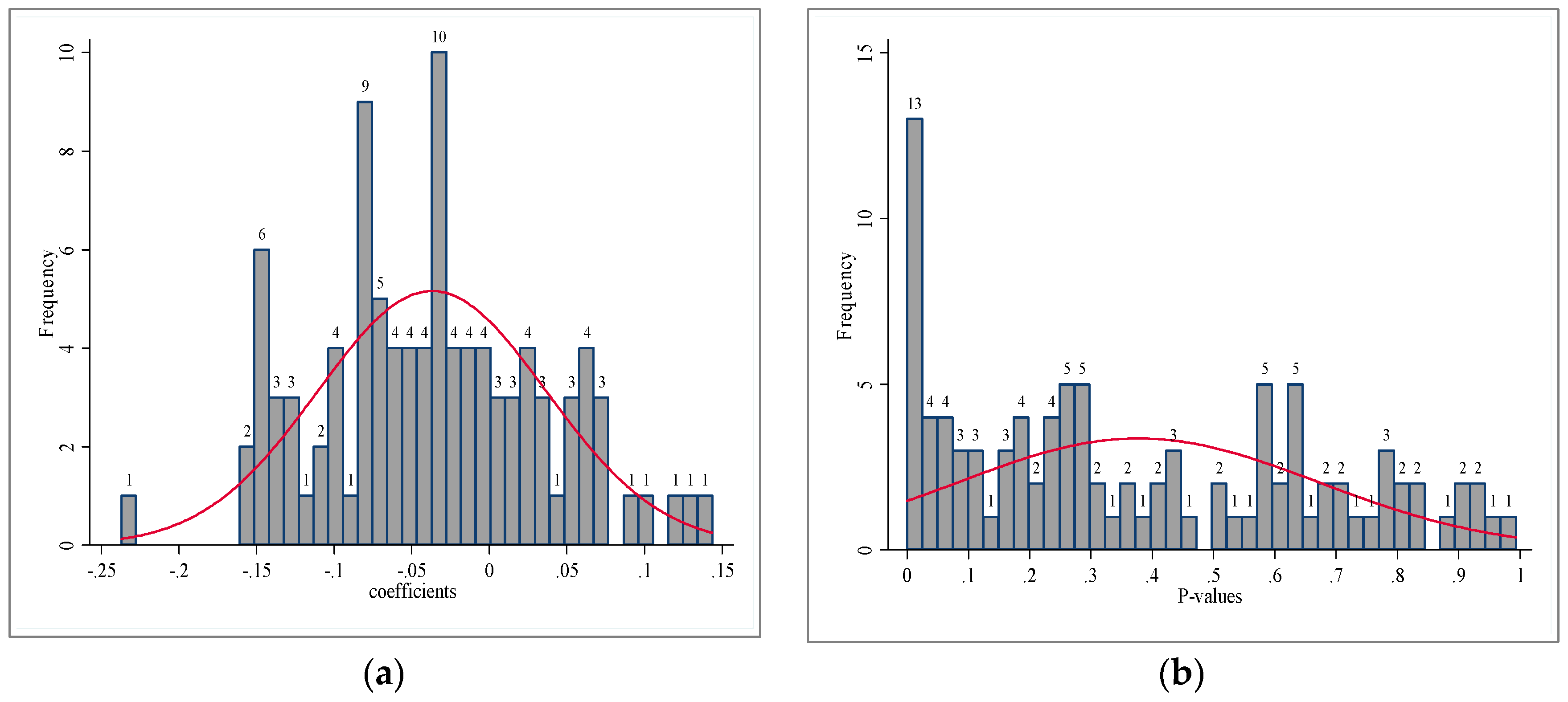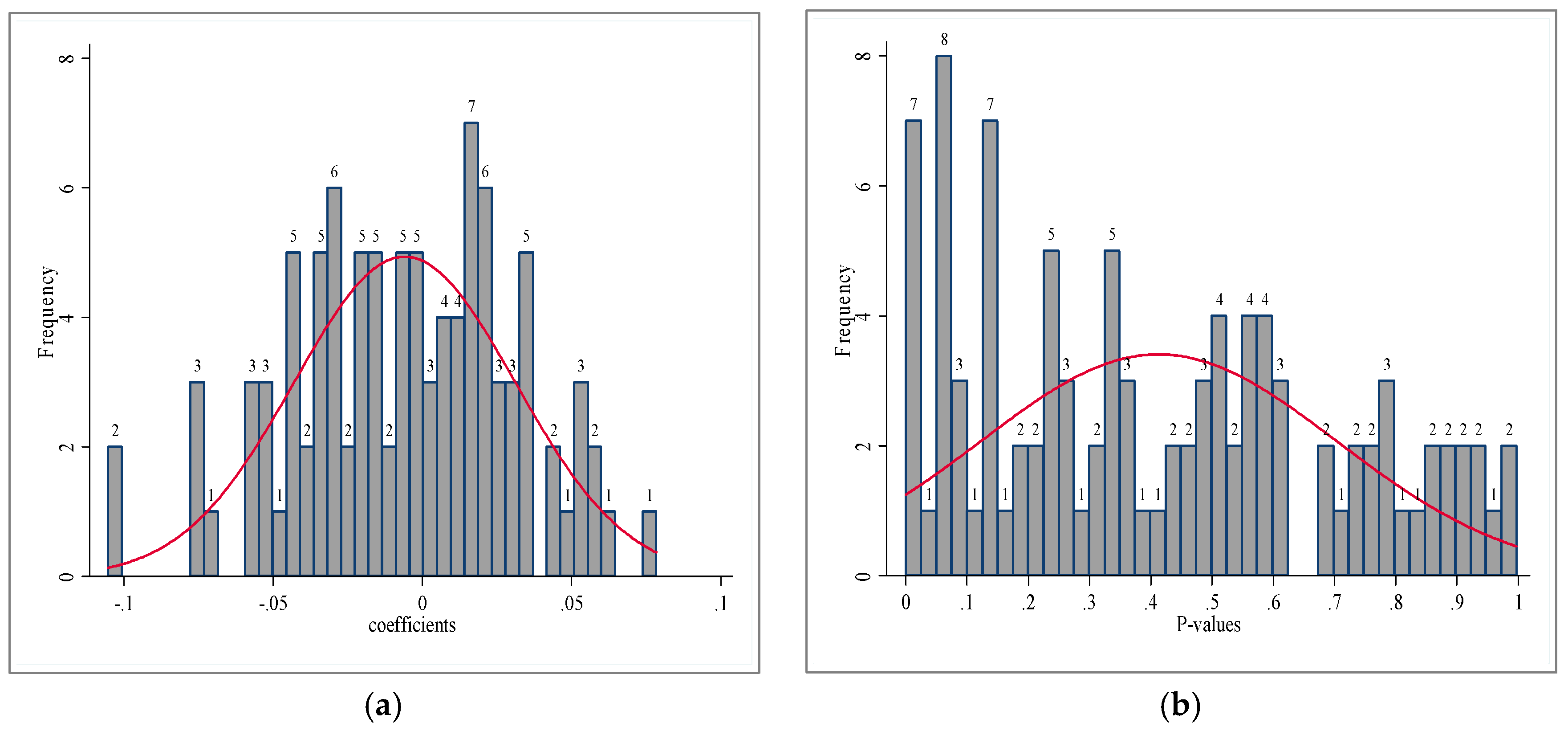1. Introduction
During the last three decades, China has witnessed impressive economic growth, along with rapid industrialization and urbanization. However, due to its resource-intensive development strategy, China’s high-growth has been accompanied by severe environmental problems. Deteriorating air quality has led to pollution-related diseases, such as lung cancer, chronic obstructive pulmonary disease (COPD), ischemic heart disease (IHD), and stroke [
1,
2]. Many industrial accidents have disastrous impacts on the environment (e.g., the Songhua River incident in the Jilin Province, see [
3]). Serious concerns have thus been raised over the long-term sustainability and hidden costs of growth [
4].
China represents an important case of environmental degradation due to growing human activities. Urbanization is one of the most important anthropogenic causes of the loss of arable land, habitat destruction, and deforestation [
5,
6,
7]. With a high density of population and industrial activities, cities have generated enormous amounts of wastes of various kinds [
8]. As China and other developing countries have entered a stage of rapid urbanization and industrialization, there are growing risks of causing irreversible damage to the global environment by human activities [
9,
10]. According to the forecast of the Organization of Economic Cooperation and Development (OECD), greenhouse gas emissions from BRIC nations (i.e., Brazil, Russia, India, and China) will grow by 46 percent from 2005 to 2030, and in total will roughly equal the emissions from the thirty OECD countries combined by 2030 [
11].
In the international context, environmental issues have been transformed from local into regional and global issues, similar to the growing regionalization and globalization of trade and investment [
12]. In a globalized world, the consequences of pollution in a country may go beyond the national boundary. While high-income countries can reduce pollution by moving industrial plants to low-income countries, pollution in the latter can be brought back to the former by atmospheric transportation. According to a recent estimate, for instance, PM
2.5 pollution in China in 2007 is associated with 64,800 premature deaths outside China, while 108,600 premature deaths in China are attributable to consumption in Western Europe and the USA [
2].
China has joined the international community in combating global climate change. The government pledged to reduce carbon dioxide emissions intensity to 40–45% of the 2005 levels by 2020 in the 2009 Copenhagen Summit, and further committed to reduce it to 60–65% of the 2005 levels by 2030 in the 2015 Paris Summit. Whether China can achieve these targets has direct bearing on future climate change. Against this backdrop, it is important to have a better understanding of China’s progress and the challenges in achieving its environmental goals.
Starting from the late 1990s, the Chinese government formulated a series of environmental regulatory laws and policies. By 2014, the National People’s Congress (NPC) had approved 10 environmental and 30 resource protection laws. Local people’s congresses and governments have developed more than 700 local environmental rules and regulations [
13].
Surprisingly, there is little consensus on the effectiveness of the policies and the causal relationship between environmental regulations and their outcomes. Some studies argue that China’s energy efficiency has improved drastically and that pollution has reduced as a result of the environmental regulation and technological improvements [
4,
14]. Others hold the opposite view. Some have argued that China has been forced to play the “race to the bottom” game with other developing countries in the fear of capital outflow. The reasoning is in line with the “pollution heaven hypothesis” which postulates that polluting industries are welcome by low-income countries with low environmental standards, even though they cannot survive in developed countries where environment regulations are strict [
15]. In this view, globalization undermines the Chinese governments’ ability to protect the environment through the regulation of corporate behavior [
16]. In addition, some studies have questioned the accuracy of official pollution statistics, as any policy that motivates local governments to reduce pollution may also motivate them to report better outcomes on paper [
17]. This is especially true under China’s regionally decentralized authoritarian (RDA) regime, where an independent judiciary, transparent information, and official accountability are all absent [
18]. Local officials are appointed by upper-level officials who heavily emphasize tangible economic outcomes such as GDP growth and revenue collection [
19,
20,
21]. Thus, pollution data collected by official organizations will more likely suffer from measurement and misreporting problems. Some have gone so far as to argue that many environmental policies exist only on paper [
22].
To contribute to this debate, we assess the effectiveness of China’s Two Control Zones (TCZ) policy that tightens the control of acid rain and the emission of sulfur dioxide (SO2) in targeted areas. The TCZ policy provides a quasi-natural experiment to compare changes in industrial activities between polluting and non-polluting industries and between prefectures within and outside the TCZ. We aggregate firm-level information collected by China’s National Statistics Bureau to two-digit industrial data at the prefecture level for the period from 1999–2009. The difference-in-differences (DID) method is used to study the effectiveness of the TCZ policy in reallocating activities away from polluting sectors over space and time.
We find that stricter environmental regulation led to a lower level of polluting activities in TCZ prefectures. Moreover, rather than a contraction of production in existing firms, the relative reduction of polluting industrial activities in TCZ prefectures was associated with a bigger number of firm closures in the targeted TCZ prefectures and the setting up of a bigger number of polluting firms in the non-targeted locations. Furthermore, the impact of the TCZ policy was more pronounced in the coastal areas as compared with inland areas. Our findings also suggest that the TCZ policy became more effective after China changed its assessment criteria for the performance of local officials in the late 2000s.
Our paper extends the previous literature in three dimensions. First, unlike existing papers that focus on pollution outcomes or air quality measured at monitoring stations [
23,
24], we use measures that are less susceptible to misreporting, including industry-level activities in China’s prefectures (industrial sales value, the number of firms in air-polluting industries, and the number of new firms in air-polluting industries). Moreover, the industrial database used in this paper covers almost all industrial firms in China, except for very tiny ones.
Second, a problem faced by existing studies is their use of aggregate data at the national, provincial, or city levels, which do not allow investigators to distinguish among changes caused by the opening of new plants, expansion or contraction of the production of existing plants, and the closures of plants [
25,
26,
27]. As firm-level information is used in this paper, we can aggregate the information in a way that allows us to understand the importance of various channels.
Third, the environmental problems of industrialization and urbanization in developing countries have received very little attention [
28]. Our study offers an attempt to analyze the effect of environmental regulations on industrial activities in developing countries. Given the pressing task of improving environmental protection, policymakers urgently need a better understanding of the complex linkages between environmental regulation and industrial activities.
Our paper is relevant to the broader issues of environmental degradation. Developing countries often put overwhelming efforts on achieving economic growth without sufficient attention to its impacts on the environment. If sustainable development is to be achieved, a proper approach should be the one that takes into account the environmental costs of economic growth [
29]. Ultimately, development should aim at improving people’s well-being, which should include not only the amount of economic goods that one consumes, but also environmental quality. Recent empirical studies suggest that concerns over ozone pollution negatively affect the well-being of an individual [
30]. China’s TCZ policy represents an attempt to tilt the balance from economic growth to environmental quality, although our results indicate that more efforts are needed.
Our assessment of China’s TCZ policy suggests that China needs not only environmental laws and regulation, but also institutional innovations. Environmental degradation is the result of market failure. A decentralized market system is expected to result in under-investment in pollution abatement and thus a suboptimal growth path [
31]. Better outcomes may be achieved by regulatory policies (e.g., taxes for polluting industries and subsidies for clean energy), the development of property rights (e.g., the right to fish), and the design of institutions (e.g., climate exchanges) which can be conceptualized as involving sustainable entrepreneurship [
32]. In the specific context of China, the RDA system has not been successful in incentivizing local officials to follow a sustainable development path, not to mention nurturing sustainable entrepreneurship.
The rest of the paper is organized as follows.
Section 2 introduces China’s TCZ policy, against the background of rising air pollution.
Section 3 describes our data set while
Section 4 explains the DID method and reports the empirical results. Robustness checks of the regression results are conducted in
Section 5, and
Section 6 concludes the paper.
2. Air Pollution and Regulations in China
Following China’s rapid industrialization and urbanization, energy consumption increased nearly 130 percent between 2000 and 2012 (see
Figure 1). Although China’s energy efficiency and resource utilization have improved drastically due to the application of cleaner and more energy-efficient technologies, coal consumption continues to account for 70% of China’s energy production. Consequently, China has become the largest source of SO
2 emissions in the world [
4].
Figure 2 shows that the emission of industrial waste gases increased along with GDP growth. Nevertheless, industrial SO
2 emission intensity and industrial soot emission intensity decreased substantially, as a result of expansion of the GDP. As can be seen in
Figure 3 and
Figure 4, the industrial SO
2 emission intensity and the industrial soot emission intensity dropped in many prefectures. It is notable that the improvement was regionally unbalanced: While the emission intensities in the east and south coastal regions reduced drastically, those in Shanxi, Henan, Hunan, Guizhou, Guangxi, Gansu, and Liaoning stayed at high levels.
Diseases caused by outdoor air pollution grew by 33% during 1990–2010, and 20% of lung cancers in 2010 could be attributed to PM
2.5 pollution [
33]. The costs of health losses due to ambient air pollution using willingness-to-pay measures was estimated to be 3.8 percent of the Gross Domestic Product (GDP) [
4]. As shown in
Figure 5, petitions and complaints on environmental issues increased by an average of 29% annually during 1996–2010 [
13].
The Chinese government has been formulating a series of environmental regulatory laws and policies. Among those related to the regulation of air pollution, the most notable one was the Two Control Zones (TCZ) policy implemented in 1998 [
37]. The two control zones refer to the sulfur dioxide control zone and acid rain control zone (see
Figure 6). Prefectures are included into the zones if the recorded emissions exceeded the national standards in the preceding years. The acid rain control area and the sulfur dioxide pollution control area are mainly located in the southern and northern areas of the Yangtze River, respectively, totaling 175 prefectures across 27 provinces. The acid rain control area is about 800,000 km
2, whereas the sulfur dioxide pollution control area is about 290,000 square kilometers, accounting for 8.4% and 3% of China’s total land area, respectively. Notably, the TCZ covers China’s fast-growing, densely populated, and industrialized areas, including the four centrally-administered municipalities, 21 provincial capital cities, 11 out of 16 coastal open cities, and four special economic zones.
The Chinese government has set several ambitious targets: (1) limiting sulfur dioxide emissions in the TCZ to the level of the year 2000; (2) achieving the national environmental quality standards for ambient air concentrations of sulfur dioxide in all the urban areas of the TCZs; (3) significantly reducing the rainfall with pH ≤ 4.5 in the Acid Rain Control Zone area.
Specific pollution control targets for TCZs were written in the Tenth Five-Year Plan (2001–2005), becoming national strategic goals for the first time [
38]. More stringent regulations have been enforced in the TCZs, for example,
prohibition of extraction in coal seams with a sulfur content over 3%;
gradually reducing the extraction in existing coal mines with a sulfur content over 3%;
mandatory installation of coal washing facilities at the appropriate scale to newly built or reconstructed mines with a sulfur content over 1.5%;
prohibition of new coal-fired power plants in large and medium-sized cities;
mandatory installation of desulphurization facilities in newly built or reconstructed coal-fired power plants with a sulfur content higher than 1%;
reducing the emissions of polluting enterprises in the chemical, metallurgy, building materials, and non-ferrous metals industries by various methods, etc.
6. Conclusions
China is a major contributor to the world’s global warming emissions. Whether China can reduce its emissions at a reasonable pace has direct bearing on the world’s battle against environmental degradation. The effectiveness of China’s environmental regulation, however, has to be understood in the context of its special institutional environment. Particularly important is the RDA regime that shapes the incentives of local officials in choosing strategies to achieve growth and environmental targets. Its long-existing heavy emphasis on growth in the assessment scheme in the past and the recent shift to higher weighting for environmental outcomes have motived local cadres to act correspondingly, taking into consideration the specific characteristics of the location under their jurisdiction. Environmental regulation such as the TCZ policy may lead to not only an overall reduction of polluting activities, but also a relocation of polluting activities across regions.
To analyze the impacts of the TCZ policy, we have applied the DID method to a unique firm-level data set covering the period from 1999–2009. We find that stricter environmental regulation led to a lower level of polluting industrial activities in TCZ prefectures, which was associated with more closures of polluting firms in targeted prefectures and more new polluting firms in non-targeted locations. In addition, our findings suggest that the TCZ policy had more pronounced effects in the coastal areas and became more effective after China changed its assessment criteria for the performance of local officials in the late 2000s.
The results are based on regressions that have controlled for a range of prefecture socioeconomic, demographic, and other characteristics, as well as a rich set of potentially time-variant two-digit industry effects and time-variant province effects to mitigate omitted variable bias. In addition, we used the PSM-DID and placebo tests to relieve concerns with the DID models, wherein the selection bias and random assignment are the fundamental challenges. We found little evidence that undermines our basic conclusions.
China ratified the Paris Agreement in 2016 and will be a key player in the world’s deep de-carbonization actions to combat the adverse impacts of climate change. Local officials are primarily responsible for implementing environmental policies under the RDA regime in China. Thus, environmental improvement in the long run may rely on refinements of the incentive system in such a way that local officials and polluting firms would be induced to embrace environmental protection.
